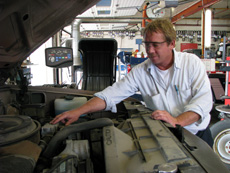Brett Lavoy keeps the pressure on alternative fuel

Mechanic and CNG cylinder inspector Brett Lavoy examines the mass air flow sensor inside one of the laboratory's CNG vehicles.
Brett Lavoy has a high-pressure job - 3,600 pounds per square inch to be precise. Few mechanics in Illinois can say that.
Only about a dozen mechanics in Illinois, including Lavoy, hold certifications to inspect gas cylinders in alternative fuel vehicles that run on compressed natural gas.
That knowledge comes in handy because Fermilab has about 35 CNG-powered vehicles. Lavoy services all of them as well as helping Argonne National Laboratory with its CNG fleet.
The two U.S. Department of Energy laboratories are among at least 80 businesses in the state to use the alternative fuel vehicles. Environment-friendly vehicles release fewer smog-producing gases, like carbon monoxide and nitrogen oxides, and less carbon dioxide.
Although compressed natural gas can be flammable, Lavoy said, it is less dangerous to work with than gasoline. Gasoline can leak and form puddles of liquid, but CNG escapes into the air and dissipates.
Lavoy loves a challenge so when head of Transportation Services George Davidson asked for a volunteer to complete training and become a certified CNG inspector, Lavoy embraced the opportunity. He completed his training last May.
Lavoy says that most inspections and repairs of CNG and non-CNG vehicles are routine and safe but recalls one alarming incident two winters ago. He reached inside an engine to find a faulty wire, and instead touched fur. It was a raccoon, huddled inside to stay warm.
"That's probably the closest I've ever been to danger," Lavoy said, thinking back on all of his years of working with CNG vehicles.
Over time, the laboratory plans to phase out CNG in favor of more efficient alternative-fuel vehicles.
As new alternative fuel options become available, Lavoy will take on the next clean energy challenge--and maybe even the next raccoon.
-- Haley Bridger
|